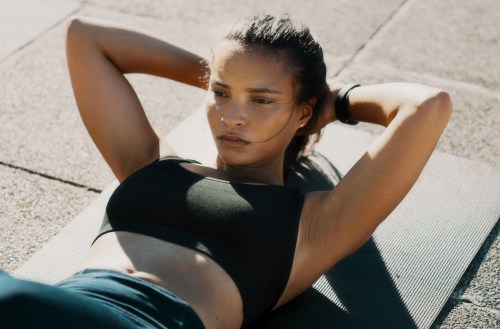The crunch cue trainers say will instantly wreck your form—and what to do instead
Pro fitness trainers explain how to do a crunch properly, and reveal the most common mistake that's keeping you from getting the most out of the move.

No matter your modality of choice, crunches are at the (literal) core of any sort of workout. They’re a fixture in everything from beginner Pilates to pro-level HIIT, and this morning I did about 50 of them in my trampoline workout. But what could be considered one of the most common moves out there is also one of the easiest to mess up, and there’s a particular mistake that trainers see people making all the time: Putting their hands behind their heads.
“When it comes to these types of exercises, we cue people to bring their hands to behind their head because it allows your shoulders to be lifted off the ground to engage the core,” says GRIT founding trainer Anthony Crouchelli. “But what tends to happen is clients crunch on their neck, causing strain.” This means you’re not working your core to its full capacity, which is why Crouchelli says it’s a big no-no—no matter what type of crunch you’re doing.
“The whole point of doing crunches is to work your abs, but if you’re pulling your neck up to try to get the motion of a crunch as opposed to actively engaging your abs, you’re actually going to hurt yourself as opposed to helping yourself,” says DOGPOUND founding trainer and chief experience officer Rhys Atahyde.
How to do a crunch properly
Instead of clasping your hands, Crouchelli suggests keeping them open so that only your middle fingers touch. “This will keep you from interlocking, which means you won’t even be able to think about yanking your neck off of the ground,” he says. If that still makes the yank too tempting, you can hover your finger tips on the sides of your ears. In either case, be sure to keep your elbows extended out to the side instead of turning them upwards.
Without the help of your hands to pull your head off of the floor, you’ll have to double down on the work coming from your abs (which is the whole point of a crunch, anyway). “Really try and imagine pushing your belly button into the floor,” says Crouchelli, and focus on gluing your lower back to the mat instead of arching your back every time you crunch up.
While you may not be able to get your head and shoulders as high off of the ground, all of the work will be coming from your core, which makes the exercise more effective. “You don’t have to get up to that 90-degree angle,” says Atahyde. “Even if you can get up to just 120 degrees, and doing the move properly, that’s better. You’d much rather have one good crunch than 100 terrible ones.”
Because this makes the move harder, you can build up to the form by first starting with your hands by your side. “You can extend your hands out to the side and push yourself up and use your hands to elevate you so that you feel like you’re engaging from the right places,” says Atahyde. “Or, you can put your hands on your stomach so that you can feel your abs and make sure you’re properly engaging them.”
Though not every crunch you do will be in perfect form—especially as you tire out those core muscles—it’s important to catch yourself when you’re doing things wrong and make adjustments. But putting your hands in the proper spot is the best way to get it right from the outset.
Now that you’ve got your crunch form down pat, put it into practice with this abs series:










